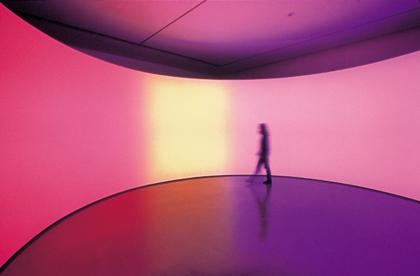By Aaron Davis
Dealing not only with light and time but also methods of displaying them, “Take your time,” a solo exhibit by Olafur Eliasson now at P.S.1 Contemporary Art Center and the Museum of Modern Art, challenges our perception of the world around us. Waterfalls will stop, showing us a stationary image with a downward flow replaying on the “screen.” In one exhibit, a waterfall will flow in reverse. Rooms will shift in space or grow incredibly bright, you will shift in space or grow incredibly bright. Islands will rise from the sea.
Part of Eliasson's project is bringing the natural world to bear on his art, yet making sure it is recognized as fabricated. “[Eliasson] is an experimental artist in an almost scientific way,” said Roxana Marcoci, the curator for the photography department at MoMA. “He is drawing attention to how cultural institutions are taking something that is a pure phenomenon and are framing this phenomenon. It is about the interstices between the two and the process aspect of the two.”
Running through June 30, “Take your time: Olafur Eliasson” is the most comprehensive exhibit of his works the United States has seen, incorporating pieces from across the world and displaying the Scandinavian-born photographer and installation artist's unique perspective on light, space, time and memory.
Born in Copenhagen, Denmark and raised in Denmark and Iceland, Eliasson uses his work to reflect the illuminating and geometric aspects of his homeland's terrain. He studied at the Royal Danish Academy of Fine Arts in Copenhagen, where he was influenced by artists such as James Turrell of California's Light and Space movement as well as discursive theorists such as Henri Bergson. Eliasson's work ties together his critical theory with the intense appreciation of nature and Iceland.
The installation entitled “Take your time” (2008), on display at P.S. 1, features a room with a large circular mirror suspended above and rotating with a minimal tilt. When viewed in this way, the mirror reflects a pulsing, warping version of the viewer and the room. Many are seen to stand near the corners of the room in an attempt to take it all in, while others lie down in the direct center. Framing the viewer within the work is essential to Eliasson's art, rather than allowing one to be an objective outside viewer as one would with a painting.
Eliasson famously toys with commonly held notions of one's perspective in relation to their environment. “Rather than construct an external field of visual objects to be consumed by an individual viewer, his panoramic format breaks down some basic, epistemological assumptions about the positions and identities of what is commonly thought to be a subject and object,” wrote Jonathan Crary, professor of art history at Columbia University, in his essay “Your Colour Memory: Illuminations of the Unforeseen.”
Color memory, which resembles the phenomenon known as an afterimage or “ghost image,” is a byproduct of the way our eyes process light. For example, when you look at the sun or a blinding light and then look away or close your eyes, you see lights. These lights are the relaxing of the eyes' photoreceptors after a tiring ordeal of processing a certain band of light. The color you see will be the complementary color of the one you focused on. If you choose to look at a blue color for a period of time and then look away, your photoreceptors, which pick up blue, will relax and will show orange, blue's complementary color.
Eliasson exploits this aspect of our retinas in many instances of his work, none more memorable than the exhibit at P.S.1 entitled “Beauty.” The viewer enters a dark room containing a pipe running across the ceiling, spraying mist downward. A spotlight is focused on the center of the mist waterfall, so that the viewer sees a sustained vignette of reflecting water molecules flowing downward, creating a cinema-like effect. This visual phenomenon is closely related to the afterimage effect and is titled the “persistence of vision” effect, in which a rapid series of pictures, can portray motion. This is the basis of modern cinema and animation.
Inherent in these installations are waking moments. Looking at the piece “Reverse waterfall” (1998), the cords powering the pumps are noticeably uncovered. In “Take Your Time,” the mechanism holding the mirror up is clearly visible. Throughout the exhibit, the bare bones of the installations are exposed, hiding nothing of the process involved in bringing art to the museum.
“If you look at all of these natural phenomena like reverse waterfalls, double sunsets, they aren't about the wonders of nature,” said MoMA's Marcoci. “He is making explicit in this installation the mechanism of the installation. The power cord is always revealed, the plug is uncovered, all of the signifiers of the laboratory.”
Eliasson's work challenges your notions of perception and lets you look at things in a way you thought you could not. A break from the normal methods of perceiving gives rise to a sense of wonder that is reserved for children and appreciators of art, yet his work allows us the distance to be conscious observers as well as participants.
If You Go:
Take your time: Olafur Eliasson
When: Through June 30, noon-6 p.m., Thursday through Monday
Where: P.S.1, 22-25 Jackson Ave., Long Island City
Cost: $5 suggested donation; $2.00 for students and senior citizens; free for MoMA members and MoMA admission ticket holders
For More: 718-784-2084 or www.ps1.org





























